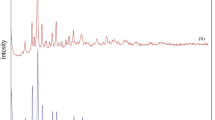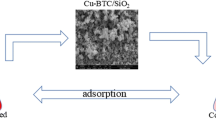Abstract
A HKUST-1 derivative composite based on LDH was synthesized to efficiently adsorb iodide anions in aqueous solutions. Specifically, Cu/Al-LDH, HKUST-1, HKUST-1@Cu/Al-LDH, Cu/Al-CLDH, Cu-C and Cu2O@Cu/Al-CLDH were synthesized and characterized. HKUST-1@Cu/Al-LDH kept the desirable characteristics of both Cu/Al-LDH and HKUST-1. Cu2O@Cu/Al-CLDH maintained the morphology of HKUST-1@Cu/Al-LDH, with its iodine anions absorption mechanism being chemical adsorption. Cu2O@Cu/Al-CLDH exhibited a significantly higher adsorption capacity than previously reported Cu-based adsorbents, with an adsorption capacity of 240.7 mg g−1 at pH 3, taking about 240 min to reach adsorption equilibrium. Thus, Cu2O@Cu/Al-CLDH is a promising adsorbent for removing iodide anions from aqueous solutions.










Similar content being viewed by others
References
Kaplan DI (2003) Influence of surface charge of an Fe-oxide and an organic matter dominated soil on iodide and pertechnetate sorption. Radiochim Acta 91:173–178. https://doi.org/10.1524/ract.91.3.173.19977
Elmekawy A, Quach Q, Abdel-Fattah TM (2022) Synthesis of a novel multifunctional organic–inorganic nanocomposite for metal ions and organic dye removals. ECS Meet Abstr. https://doi.org/10.1149/ma2022-028672mtgabs
Yu W, Dong Q, Yu W et al (2022) Preparation of halloysite/Ag2O nanomaterials and their performance for iodide adsorption. Minerals 12:304. https://doi.org/10.3390/min12030304
Nagata T, Fukushi K, Takahashi Y (2009) Prediction of iodide adsorption on oxides by surface complexation modeling with spectroscopic confirmation. J Colloid Interface Sci 332:309–316. https://doi.org/10.1016/j.jcis.2008.12.037
Attallah MF, Rizk SE, El Afifi EM (2018) Efficient removal of iodine and chromium as anionic species from radioactive liquid waste using prepared iron oxide nanofibers. J Radioanal Nucl Chem 317:933–945. https://doi.org/10.1007/s10967-018-5938-6
Niazi A, Niazi S (2011) Endocrine effects of Fukushima: radiation-induced endocrinopathy. Indian J Endocrinol Metab 15:91–95. https://doi.org/10.4103/2230-8210.81936
Groen RS, Bae JY, Lim KJ (2012) Fear of the unknown: ionizing radiation exposure during pregnancy. Am J Obstet Gynecol 206:456–462
Mao P, Yu X, Liu K et al (2020) Rapid and reversible adsorption of radioactive iodide from wastewaters by green and low-cost palygorskite-based microspheres. J Radioanal Nucl Chem 325:303–313. https://doi.org/10.1007/s10967-020-07231-4
Wan J, Li Y, Jiang Y et al (2021) Silver-doped MIL-101(Cr) for rapid and effective capture of iodide in water environment: exploration on adsorption mechanism. J Radioanal Nucl Chem 328:1041–1054. https://doi.org/10.1007/s10967-021-07705-z
Mao P, Qi L, Liu X et al (2017) Synthesis of Cu/Cu2O hydrides for enhanced removal of iodide from water. J Hazard Mater 328:21–28. https://doi.org/10.1016/j.jhazmat.2016.12.065
Chen J, Gu A, Miensah ED et al (2021) Cu–Zn bimetal ZIFs derived nanowhisker zero-valent copper decorated ZnO nanocomposites induced oxygen activation for high-efficiency iodide elimination. J Hazard Mater 416:126097. https://doi.org/10.1016/j.jhazmat.2021.126097
Liang L, Li L (2007) Adsorption behavior of calcined layered double hydroxides towards removal of iodide contaminants. J Radioanal Nucl Chem 273:221–226. https://doi.org/10.1007/s10967-007-0740-x
Laipan M, Yu J, Zhu R et al (2020) Functionalized layered double hydroxides for innovative applications. Mater Horiz 7:715–745
Theiss FL, Ayoko GA, Frost RL (2016) Iodide removal using LDH technology. Chem Eng J 296:300–309. https://doi.org/10.1016/j.cej.2016.02.039
Yu F, Chen Y, Wang Y et al (2020) Synthesis of metal–organic framework nanocrystals immobilized with 3D flowerlike Cu–Bi-layered double hydroxides for iodine efficient removal. J Mater Res 35:299–311. https://doi.org/10.1557/JMR.2020.1
Jing F, Zhang Y, Luo S et al (2010) Nano-size MZnAl (M = Cu Co, Ni) metal oxides obtained by combining hydrothermal synthesis with urea homogeneous precipitation procedures. Appl Clay Sci 48:203–207. https://doi.org/10.1016/j.clay.2009.11.039
Küsgens P, Rose M, Senkovska I et al (2009) Characterization of metal–organic frameworks by water adsorption. Microporous Mesoporous Mater 120:325–330. https://doi.org/10.1016/j.micromeso.2008.11.020
Wang Z, Fu L, Zhu Y et al (2021) Chemodynamic/photothermal synergistic therapy based on Ce-doped Cu–Al layered double hydroxides. J Mater Chem B 9:710–718. https://doi.org/10.1039/d0tb02547j
Yang A, Li P, Zhong J (2019) Facile preparation of low-cost HKUST-1 with lattice vacancies and high-efficiency adsorption for uranium. RSC Adv 9:10320–10325. https://doi.org/10.1039/c9ra01427f
He Z, Zhu Y (2014) Reduced graphene oxide-cuprous oxide hybrid nanopowders: solvothermal synthesis and electrochemical performance. Mater Sci Semicond Process 27:1013–1019. https://doi.org/10.1016/j.mssp.2014.08.045
Zhu Q, Zhang Y, Wu F et al (2014) Mineral wool fibers incorporated with cuprous oxide for visible light photocatalytic inactivation of Escherichia coli. Ceram Int 40:5407–5412. https://doi.org/10.1016/j.ceramint.2013.10.122
Lee YH, Leu IC, Liao CL et al (2006) Fabrication and characterization of Cu2O nanorod arrays and their electrochemical performance in Li-ion batteries. Electrochem Solid-State Lett 9:A207. https://doi.org/10.1149/1.2171815
Li H, Zhu L, Wu S et al (2017) Synergy of CuO and CeO2 combination for mercury oxidation under low-temperature selective catalytic reduction atmosphere. Int J Coal Geol 170:69–76. https://doi.org/10.1016/j.coal.2016.07.011
Wanger CD, Riggs WM, Davis LE et al (1979) Handbook of X-ray photoelectron spectroscopy. Perkin-Elmer Corp., Physical Electronics Division, Eden Prairie
Li Z, Huang X, Lin L et al (2021) Polyphenol and Cu2+ surface-modified chitin sponge synergizes with antibacterial, antioxidant and pro-vascularization activities for effective scarless regeneration of burned skin. Chem Eng J 419:129488. https://doi.org/10.1016/j.cej.2021.129488
Jeong N, Kim H, Kim W et al (2020) Direct synthesis, characterization, and reverse electrodialysis applications of MoS2 thin film on aluminum foil. Mater Charact 164:110361. https://doi.org/10.1016/j.matchar.2020.110361
Moritz P, Höfft O, Wegewitz L, Maus-Friedrichs W (2023) Interaction of cyanoacrylate with metal oxide surfaces (Cu, Al). ChemPhysChem. https://doi.org/10.1002/cphc.202300076
Mićić RD, Marinković-Nedučin RP, Schay Z et al (2007) Influence of the activation temperature on structural and textural properties of NiMo/Al2O3 hydrodesulfurization catalysts. React Kinet Catal Lett 91:85–92. https://doi.org/10.1007/s11144-007-4979-6
Asami K, Mitani S, Fujimori H et al (1999) Characterization of Co–Al–O magnetic thin films by combined use of XPS, XRD and EPMA. Surf Interface Anal 28:250–253. https://doi.org/10.1002/(SICI)1096-9918(199908)28:1%3c250::AID-SIA587%3e3.0.CO;2-T
Nguyen TP, Amgaad K, Cailler M et al (1995) XPS analysis of thermal and plasma treated polyparaphenylene-vinylene thin films and their interface formed with aluminum layer. Synth Met 69:495–496. https://doi.org/10.1016/0379-6779(94)02541-6
Pan R, Tang Y, Guo Y et al (2021) HKUST-1 and its graphene oxide composites: finding an efficient adsorbent for SO2 capture. Microporous Mesoporous Mater 323:111197. https://doi.org/10.1016/j.micromeso.2021.111197
Zhang J, Shao J, Zhang X et al (2023) Facile synthesis of Cu-BTC@biochar with controlled morphology for effective toluene adsorption at medium–high temperature. Chem Eng J 452:139003. https://doi.org/10.1016/j.cej.2022.139003
Hao X, Jin Z, Yang H et al (2017) Peculiar synergetic effect of MoS2 quantum dots and graphene on metal–organic frameworks for photocatalytic hydrogen evolution. Appl Catal B 210:45–56. https://doi.org/10.1016/j.apcatb.2017.03.057
Jin Z, Zhang L (2020) Performance of Ni–Cu bimetallic co-catalyst g-C3N4 nanosheets for improving hydrogen evolution. J Mater Sci Technol 49:144–156. https://doi.org/10.1016/j.jmst.2020.02.025
Tang L, Liu Y, Wang J et al (2018) Enhanced activation process of persulfate by mesoporous carbon for degradation of aqueous organic pollutants: electron transfer mechanism. Appl Catal B 231:1–10. https://doi.org/10.1016/j.apcatb.2018.02.059
Osuna FJ, Pavón E, Pazos MC, Alba MD (2021) Designed organomicaceous materials for efficient adsorption of iodine. J Environ Chem Eng 9:106577. https://doi.org/10.1016/j.jece.2021.106577
Seon J, Hwang Y (2021) Cu/Cu2O-immobilized cellulosic filter for enhanced iodide removal from water. J Hazard Mater 409:124415. https://doi.org/10.1016/j.jhazmat.2020.124415
Jiao H, Li Y, Gao K et al (2020) Efficient removal of radioactive iodide by three-dimensional Cu@Cu2O: an adsorption and electrocatalytic oxidation coupling process. Colloids Surf A Physicochem Eng Asp 602:124964. https://doi.org/10.1016/j.colsurfa.2020.124964
Zhang X, Gu P, Zhou S et al (2018) Large-scale synthesis of nano Cu2O/Cu–C for iodide removal in a novel countercurrent two-stage adsorption and membrane separator system. J Radioanal Nucl Chem 317:959–968. https://doi.org/10.1007/s10967-018-5968-0
Zhang X, Gu P, Li X, Zhang G (2017) Efficient adsorption of radioactive iodide ion from simulated wastewater by nano Cu2O/Cu modified activated carbon. Chem Eng J 322:129–139. https://doi.org/10.1016/j.cej.2017.03.102
Wang P, Gong CH, Tang AY et al (2023) Cu-BTC derived CuO and CuO/Cu2O composite: an efficient adsorption material to iodide ions. Mater Res Express 10:025005. https://doi.org/10.1088/2053-1591/acb981
Acknowledgements
The present work was supported by Project supported by the National Natural Science Foundation of China (Grant No. 11905106); the Fundamental Research Funds for the Central Universities (Grant No. 30921013110); the Provincial Ecological Environment Research Project of Jiangsu (Grant No. 2022017); Chinese Postdoctoral Science Foundation (Grant No. 2022M711631).
Author information
Authors and Affiliations
Corresponding author
Ethics declarations
Conflict of interest
The authors declare that they have no conflicts of interest regarding this work.
Additional information
Publisher's Note
Springer Nature remains neutral with regard to jurisdictional claims in published maps and institutional affiliations.
Rights and permissions
Springer Nature or its licensor (e.g. a society or other partner) holds exclusive rights to this article under a publishing agreement with the author(s) or other rightsholder(s); author self-archiving of the accepted manuscript version of this article is solely governed by the terms of such publishing agreement and applicable law.
About this article
Cite this article
Gong, CH., Li, ZY., Chen, KW. et al. Synthesis and characterization of Cu2O@Cu/Al-CLDH for efficient adsorption of iodide anions in aqueous solutions. J Radioanal Nucl Chem 332, 2793–2805 (2023). https://doi.org/10.1007/s10967-023-08943-z
Received:
Accepted:
Published:
Issue Date:
DOI: https://doi.org/10.1007/s10967-023-08943-z




